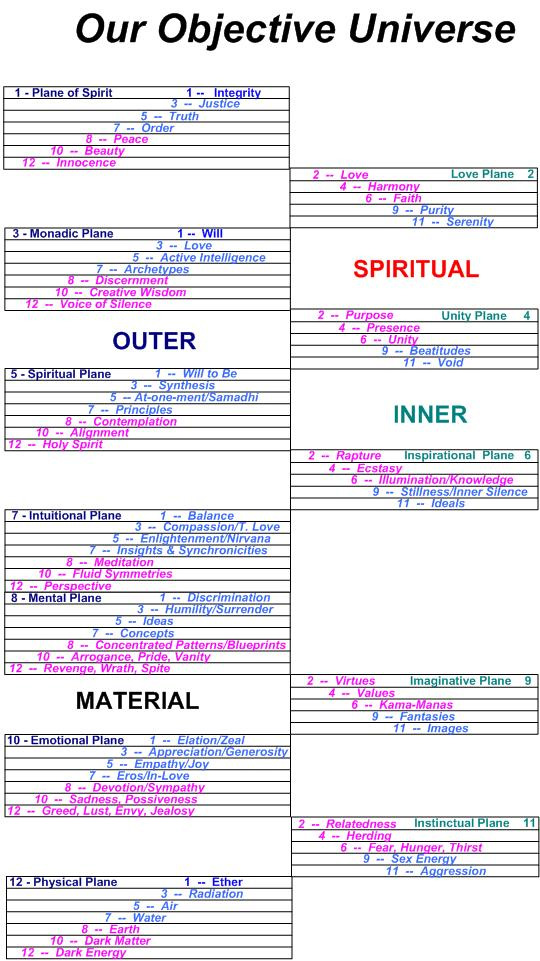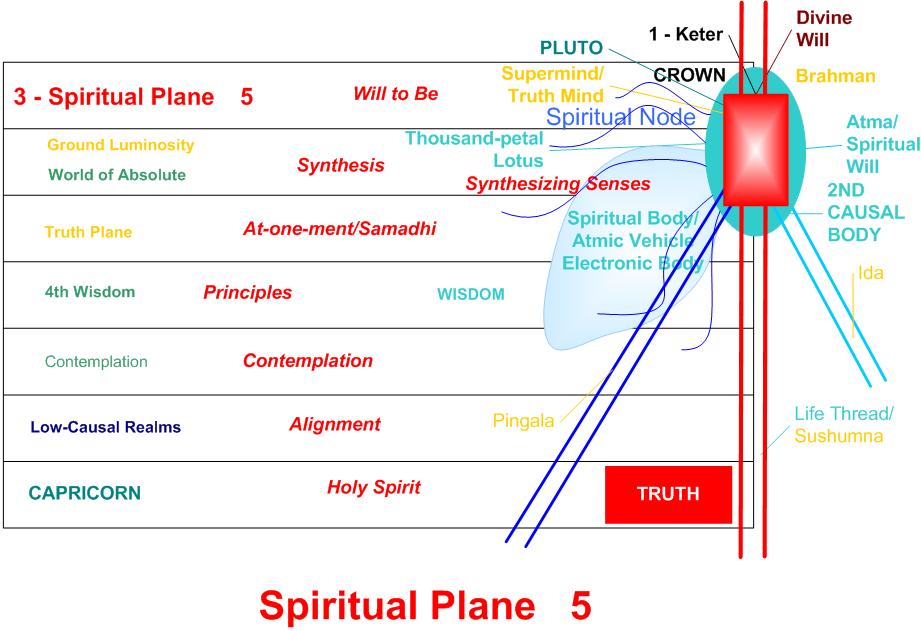 The 6th subplane energy of the Spiritual Plane is alignment. Webster's defines align as "to bring parts or components into proper coordination." This aligning energy brings the process of meditation into proper coordination preparatory to entering contemplation. It also helps us maintain an outer alignment along the spiritual growth process prior to At-one-ment, or the true state of samadhi. The energy of alignment creates the proper coordination needed for experiencing higher spiritual energies. In a meditative "trance state" this energy produces a physical rigidity as though you are encased in a steel straitjacket with literally no range of physical movement possible.
The 6th subplane energy of the Spiritual Plane is alignment. Webster's defines align as "to bring parts or components into proper coordination." This aligning energy brings the process of meditation into proper coordination preparatory to entering contemplation. It also helps us maintain an outer alignment along the spiritual growth process prior to At-one-ment, or the true state of samadhi. The energy of alignment creates the proper coordination needed for experiencing higher spiritual energies. In a meditative "trance state" this energy produces a physical rigidity as though you are encased in a steel straitjacket with literally no range of physical movement possible.
 Stepping beyond alignment, we enter the energy of contemplation. What concentration is to the Mental Plane and meditation is to the Intuitional Plane, contemplation is to the Spiritual Plane. The energy of contemplation is a purposeful vitalizing creative energy. Work from this energy state is that of transmutation, the creative change and re-qualification of manifested existence. I can best describe this state as a quiet point withdrawn from all the active processes in our head, heart and body. The intent of contemplation, similar to problem solving, is creating a resolution to the object of contemplation. Our sense of synthesis working in contemplation produces the unity and synthesis of Truth to any situation or problem.
Stepping beyond alignment, we enter the energy of contemplation. What concentration is to the Mental Plane and meditation is to the Intuitional Plane, contemplation is to the Spiritual Plane. The energy of contemplation is a purposeful vitalizing creative energy. Work from this energy state is that of transmutation, the creative change and re-qualification of manifested existence. I can best describe this state as a quiet point withdrawn from all the active processes in our head, heart and body. The intent of contemplation, similar to problem solving, is creating a resolution to the object of contemplation. Our sense of synthesis working in contemplation produces the unity and synthesis of Truth to any situation or problem.
 Central to the Spiritual Plane is the energy of Principles. I used principle here with the capital P. to differentiate these Principles from the way we relate to principles intellectually. A principle is a fundamental truth or motivating force upon which others are based. A principle is the source, origin or cause of something. The Tibetan refers to principles as essential types of energy upon which all others are built. One way to understand this is that Principles from the Spiritual Plane, as fundamental motivating energies, unfold into the ordered principles (synchronicities and insights) of the Intuitional Plane. These ordered principles then unfold into the principles (concepts) of our thinking and mental orientation, which become the basis for our actions.
Central to the Spiritual Plane is the energy of Principles. I used principle here with the capital P. to differentiate these Principles from the way we relate to principles intellectually. A principle is a fundamental truth or motivating force upon which others are based. A principle is the source, origin or cause of something. The Tibetan refers to principles as essential types of energy upon which all others are built. One way to understand this is that Principles from the Spiritual Plane, as fundamental motivating energies, unfold into the ordered principles (synchronicities and insights) of the Intuitional Plane. These ordered principles then unfold into the principles (concepts) of our thinking and mental orientation, which become the basis for our actions.
 Entering the higher energies of our spirituality, we contact what has been labeled samadhi or At-one-ment. As shown in the figure above, this energy is where we connect with our internal Spiritual Node of Atma, Spiritual Will or Divine Will which is surrounded by our second causal body, our spiritual or electronic body and our Thousand-pedal Lotus or Head Center. Another term for this energetic environment is "Eternal Tao." This spiritual Will is the originating purposeful directing energy within us. The key word here is within, for everything beyond this energy state in the Spiritual Plane is transcendent to Man in manifestation. To paraphrase The Tibetan: spiritual will is a force that brings all forms to ultimate perfection by the power of the indwelling life which becomes perfectly atoned.
Entering the higher energies of our spirituality, we contact what has been labeled samadhi or At-one-ment. As shown in the figure above, this energy is where we connect with our internal Spiritual Node of Atma, Spiritual Will or Divine Will which is surrounded by our second causal body, our spiritual or electronic body and our Thousand-pedal Lotus or Head Center. Another term for this energetic environment is "Eternal Tao." This spiritual Will is the originating purposeful directing energy within us. The key word here is within, for everything beyond this energy state in the Spiritual Plane is transcendent to Man in manifestation. To paraphrase The Tibetan: spiritual will is a force that brings all forms to ultimate perfection by the power of the indwelling life which becomes perfectly atoned.
 From these various perspectives, I define our spiritual sense of comprehension as a faculty that is aware of and learns Truth simultaneously in its wholeness and discrete parts. Everything relevant is inclusively provided so that there is no possibility of avoidance or denial. An excellent example of comprehension is Mozart's receiving an entire symphony at one time.
From these various perspectives, I define our spiritual sense of comprehension as a faculty that is aware of and learns Truth simultaneously in its wholeness and discrete parts. Everything relevant is inclusively provided so that there is no possibility of avoidance or denial. An excellent example of comprehension is Mozart's receiving an entire symphony at one time.
 Our next spiritual sense is that of beatitudes. Within Western mysticism, the beatitudes include righteousness, temperance, charitableness, courage, gentleness, meekness, hope, kindness, long-suffering, mercy, perseverance and patience. This is in addition to a number of characteristics of Spirit. Eastern mysticism define six perfections which include generosity, virtue, patience, perseverance, meditation and wisdom.
Our next spiritual sense is that of beatitudes. Within Western mysticism, the beatitudes include righteousness, temperance, charitableness, courage, gentleness, meekness, hope, kindness, long-suffering, mercy, perseverance and patience. This is in addition to a number of characteristics of Spirit. Eastern mysticism define six perfections which include generosity, virtue, patience, perseverance, meditation and wisdom.
 Each of these can be seen as faculties, capacities or powers. For example, temperance is how we learn to control and transform our ego and instinctive nature. Charity is a powerful mechanism for learning to love and transmute our selfishness. And perseverance is simply the mechanism and growing power to endure the trials and tribulations of spiritual growth until we become the Self and the Being we can be.
Each of these can be seen as faculties, capacities or powers. For example, temperance is how we learn to control and transform our ego and instinctive nature. Charity is a powerful mechanism for learning to love and transmute our selfishness. And perseverance is simply the mechanism and growing power to endure the trials and tribulations of spiritual growth until we become the Self and the Being we can be.
Take a Journey through our
Spirit/Matter Universe
Humanity's Spiritual Center
by Jef Bartow
 We would naturally think that the Spiritual Plane would be the highest spiritual energies within our systemic universe. Instead, metaphysics chose to define the Spiritual Plane as the highest energies within our "Tree of Life" energy structure. As will be described in upcoming articles, there are four higher levels of objective spiritual energies/Planes above the Spiritual Plane.
We would naturally think that the Spiritual Plane would be the highest spiritual energies within our systemic universe. Instead, metaphysics chose to define the Spiritual Plane as the highest energies within our "Tree of Life" energy structure. As will be described in upcoming articles, there are four higher levels of objective spiritual energies/Planes above the Spiritual Plane.
 As outlined in an earlier article, our personality life and later spiritual life is energized by what Kabbalah defines as our Tree of Life. This energy structure vitalizes all levels of our existence. The highest energy node within our Tree of Life is labeled by Kabbalah as Keter or Crown. Within other philosophical systems this energy center is labeled Brahman, Atma, Supermind, Spiritual Will or Divine Will. From this highest center also called the thousand-petal lotus, energies flow down into all parts of our spiritual and personality life.
As outlined in an earlier article, our personality life and later spiritual life is energized by what Kabbalah defines as our Tree of Life. This energy structure vitalizes all levels of our existence. The highest energy node within our Tree of Life is labeled by Kabbalah as Keter or Crown. Within other philosophical systems this energy center is labeled Brahman, Atma, Supermind, Spiritual Will or Divine Will. From this highest center also called the thousand-petal lotus, energies flow down into all parts of our spiritual and personality life.
 What would seem somewhat incomprehensible, we can develop spiritual senses and a spiritual body within these energies. As shown in the figure below, there are also various terms that have been used to describe this body. If we remember that synonymous terms for senses include faculties, powers, capacities and life's mechanisms; senses can be developed within every Plane to facilitate us in becoming aware of, learning, controlling, growing and transforming ourselves and our environment.
What would seem somewhat incomprehensible, we can develop spiritual senses and a spiritual body within these energies. As shown in the figure below, there are also various terms that have been used to describe this body. If we remember that synonymous terms for senses include faculties, powers, capacities and life's mechanisms; senses can be developed within every Plane to facilitate us in becoming aware of, learning, controlling, growing and transforming ourselves and our environment.
Our articles are available for reproduction for all members. Please give credit to the author.
For non-members, contact us for permission to reproduce articles.
 Another of our spiritual senses, which I believe is a good term for this entire group of senses, is synthesis. Philosophically, Kant defined two levels of synthesis including a "synthesis of apprehension." This synthesis of apprehension produces a "unity of intuition" based on a framework of principles. Psychologically, Carl Jung defined the "goal of the individuation process" as the "synthesis of the self." In doing so, we become a "likeness to God" and a "hermathrodite." Metaphysically, The Tibetan relates synthesis to unification and the "unfoldment of divine Insight" beyond illumination. He considers the Thousand-petal Lotus or "Head Center" to be our "organ of synthesis."
Another of our spiritual senses, which I believe is a good term for this entire group of senses, is synthesis. Philosophically, Kant defined two levels of synthesis including a "synthesis of apprehension." This synthesis of apprehension produces a "unity of intuition" based on a framework of principles. Psychologically, Carl Jung defined the "goal of the individuation process" as the "synthesis of the self." In doing so, we become a "likeness to God" and a "hermathrodite." Metaphysically, The Tibetan relates synthesis to unification and the "unfoldment of divine Insight" beyond illumination. He considers the Thousand-petal Lotus or "Head Center" to be our "organ of synthesis."
 Our sense of synthesis is self-perception and cognition based on a framework of principles. Externally, this provides us with the ability to perceive the Whole or One, from which all the diversity of expression originates. Internally, the faculty of divine Insight helps us produce a unification of the Self and Personality in manifestation. Through synthesizing both the conscious and unconscious, our sense of synthesis provides us the power to bring the many parts of ourselves into a unified One.
Our sense of synthesis is self-perception and cognition based on a framework of principles. Externally, this provides us with the ability to perceive the Whole or One, from which all the diversity of expression originates. Internally, the faculty of divine Insight helps us produce a unification of the Self and Personality in manifestation. Through synthesizing both the conscious and unconscious, our sense of synthesis provides us the power to bring the many parts of ourselves into a unified One.
 To me, a higher form of synthesis is our potential spiritual sense of discernment. Descartes described discernment as the ability to "grasp each truth by means of a single and distinct act which is similar in every case." The apostle Paul described spiritual discernment in the following: "But the natural man received not the things of the Spirit of God: for they are foolishness unto him: neither can he know them, because they are spiritually discerned." Eastern mysticism describes discernment as the "recognition of the distinction between the real (sat) and unreal (asat), truth and fiction, and particularly the transcendent Self and the ‘nonself’ (anatman)."
To me, a higher form of synthesis is our potential spiritual sense of discernment. Descartes described discernment as the ability to "grasp each truth by means of a single and distinct act which is similar in every case." The apostle Paul described spiritual discernment in the following: "But the natural man received not the things of the Spirit of God: for they are foolishness unto him: neither can he know them, because they are spiritually discerned." Eastern mysticism describes discernment as the "recognition of the distinction between the real (sat) and unreal (asat), truth and fiction, and particularly the transcendent Self and the ‘nonself’ (anatman)."
 Both abstract thinking and intuitive perception relate to perceiving and learning about the Spiritual Planes of unifying wholeness we have been describing in recent articles. Beyond this, knowing and discernment provide faculties for becoming aware and learning the things of the Spirit of God (synthesizing abstractions). These are the energies we will be describing in the next few articles beyond the Spiritual Plane. Our sense of spiritual discernment brings us into the depths of Truth beyond our highest principles.
Both abstract thinking and intuitive perception relate to perceiving and learning about the Spiritual Planes of unifying wholeness we have been describing in recent articles. Beyond this, knowing and discernment provide faculties for becoming aware and learning the things of the Spirit of God (synthesizing abstractions). These are the energies we will be describing in the next few articles beyond the Spiritual Plane. Our sense of spiritual discernment brings us into the depths of Truth beyond our highest principles.
 Our last spiritual sense is aptly termed perfection. Sri Aurobindo describes our spiritual self-perfection as "growing into oneness with the nature of divine being." Through "union with the supreme Being, Consciousness and Bliss," we become "an instrument of the divine knowledge, will and joy of existence." Spinoza brings perfection close to a faculty or sense by defining it as a mode of thinking. Moving to a greater perfection means our "our activity" has been increased. Perfection here is the power to bring to completion. Finally, The Tibetan essentially equates perfection to a "healing force which brings all forms to an ultimate perfection through the power the indwelling life, with which it becomes perfectly atoned."
Our last spiritual sense is aptly termed perfection. Sri Aurobindo describes our spiritual self-perfection as "growing into oneness with the nature of divine being." Through "union with the supreme Being, Consciousness and Bliss," we become "an instrument of the divine knowledge, will and joy of existence." Spinoza brings perfection close to a faculty or sense by defining it as a mode of thinking. Moving to a greater perfection means our "our activity" has been increased. Perfection here is the power to bring to completion. Finally, The Tibetan essentially equates perfection to a "healing force which brings all forms to an ultimate perfection through the power the indwelling life, with which it becomes perfectly atoned."
 As our highest most spiritual sense, perfection is our ultimate inborn faculty of creativity which will bring us the great accomplishment of our destiny and purpose. With it, we are also made perfect in the oneness of our Christ Self. This power not only brings completion, but actualizes the potentialities of our totality as a manifested Monad (our God Within).
As our highest most spiritual sense, perfection is our ultimate inborn faculty of creativity which will bring us the great accomplishment of our destiny and purpose. With it, we are also made perfect in the oneness of our Christ Self. This power not only brings completion, but actualizes the potentialities of our totality as a manifested Monad (our God Within).
Our Spiritual Energies
 As you can imagine, the various sub-levels of the Spiritual Plane include energies that most humans rarely experience. Various mystics and sages describe their experiences, but rarely has this brought forth an easy ability to understand the terms they use. I'm not going to try to make this easy to understand, only to provide you a concise means to meditate your way toward these spiritual energies.
As you can imagine, the various sub-levels of the Spiritual Plane include energies that most humans rarely experience. Various mystics and sages describe their experiences, but rarely has this brought forth an easy ability to understand the terms they use. I'm not going to try to make this easy to understand, only to provide you a concise means to meditate your way toward these spiritual energies.
 The closest Spiritual Plane energy connected to our personality is that of the Holy Spirit. As Christ left, he left behind the “Comforter” which will lead us into all Truth. The Holy Spirit’s close connection with every 7th subplane of each Plane enables every human to make contact with. This energy can be powerfully experienced in Pentecostal and charismatic churches within Christianity. When the Holy Spirit comes into you, it's like warm electricity that energizes your whole body. It electrifies whatever emotions seem to be near the surface. The first few times you experience it, it seemingly bypasses your normal mental orientation and rips open your heart.
The closest Spiritual Plane energy connected to our personality is that of the Holy Spirit. As Christ left, he left behind the “Comforter” which will lead us into all Truth. The Holy Spirit’s close connection with every 7th subplane of each Plane enables every human to make contact with. This energy can be powerfully experienced in Pentecostal and charismatic churches within Christianity. When the Holy Spirit comes into you, it's like warm electricity that energizes your whole body. It electrifies whatever emotions seem to be near the surface. The first few times you experience it, it seemingly bypasses your normal mental orientation and rips open your heart.
Our Spiritual Senses
 As has been described for each Plane, we can actualize five senses within the Spiritual Plane. These five senses include comprehension, beatitudes, synthesis, discernment and perfection. On the surface, some of these do not seem like they would be considered senses. So let's see how we can make sense of these senses.
As has been described for each Plane, we can actualize five senses within the Spiritual Plane. These five senses include comprehension, beatitudes, synthesis, discernment and perfection. On the surface, some of these do not seem like they would be considered senses. So let's see how we can make sense of these senses.
 The first potential sense that we can actualize from our Spiritual Node is that of comprehension. Webster's includes the following characteristics of to comprehend: "include, seize, to take in" and "to catch hold of." The philosopher Kant equated comprehend with to "cognize it to the extent necessary for our purposes." Metaphysically, the "fire of comprehension" is used to destroy "all the glamours which may hide or veil the immediate point of an illumination for the disciple."
The first potential sense that we can actualize from our Spiritual Node is that of comprehension. Webster's includes the following characteristics of to comprehend: "include, seize, to take in" and "to catch hold of." The philosopher Kant equated comprehend with to "cognize it to the extent necessary for our purposes." Metaphysically, the "fire of comprehension" is used to destroy "all the glamours which may hide or veil the immediate point of an illumination for the disciple." From another perspective, The Tibetan equated comprehension with the "synthetic immediate grasp of the truths." "Synthetic comprehension" is seeing "not only the periphery of the Whole but the beauty of purpose of every aspect of the inner structure."
From another perspective, The Tibetan equated comprehension with the "synthetic immediate grasp of the truths." "Synthetic comprehension" is seeing "not only the periphery of the Whole but the beauty of purpose of every aspect of the inner structure."
 Energetically, our next step up is that of synthesis. It might seem confusing that synthesis is both a spiritual sense and an energy. But remember, we did the same with appreciation in the Emotional Plane. What this spiritual sense does for us, this energy does for higher spiritual characteristics of Spirit to be conveyed into the environment of Man. These characteristics include Harmony, Justice, Love and Integrity. I describe this 2nd subplane synthesis as a unifying, just, harmonious, loving energy. Its attractiveness upwardly draws us into the subtle domain of true Synthesis.
Energetically, our next step up is that of synthesis. It might seem confusing that synthesis is both a spiritual sense and an energy. But remember, we did the same with appreciation in the Emotional Plane. What this spiritual sense does for us, this energy does for higher spiritual characteristics of Spirit to be conveyed into the environment of Man. These characteristics include Harmony, Justice, Love and Integrity. I describe this 2nd subplane synthesis as a unifying, just, harmonious, loving energy. Its attractiveness upwardly draws us into the subtle domain of true Synthesis.
 To complete our description of the Spiritual Plane, we come to the 1st subplane and the will-to-be. I label it as such because of its attractive nature. One of the only ways that I can describe this will-to-be is as a catapulting energy into Spirit. As spiritual Will is a purposeful directing force for us in manifestation, this will-to-be is a purposeful directing force of abstraction out of manifestation.
To complete our description of the Spiritual Plane, we come to the 1st subplane and the will-to-be. I label it as such because of its attractive nature. One of the only ways that I can describe this will-to-be is as a catapulting energy into Spirit. As spiritual Will is a purposeful directing force for us in manifestation, this will-to-be is a purposeful directing force of abstraction out of manifestation.






